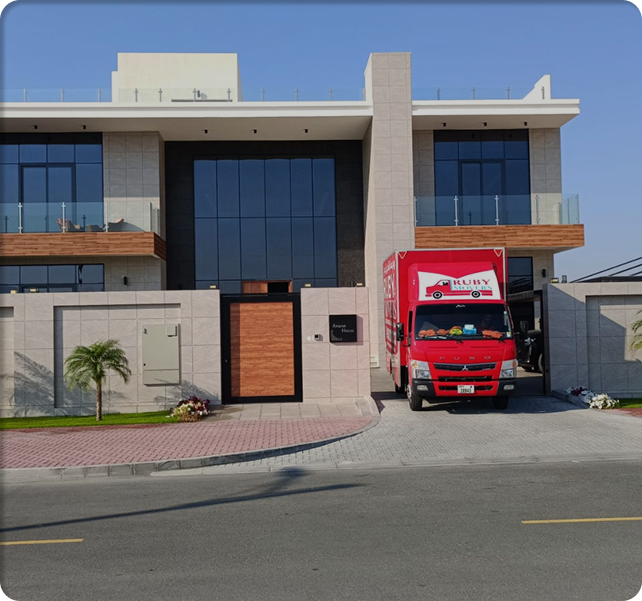Moving with children feels chaotic. Sleep breaks. Meals slip. Boxes hide essentials. In Dubai, permits, Ejari, DEWA, and district cooling add pressure. Parents want calm nights and a fast settle. This guide delivers a clear path.
You get a practical system that reduces meltdowns and delays. The focus stays on child stability and safety. Every step aligns with evidence and UAE rules. Outcomes: earlier lights out, predictable meals, faster unpacking.
What this article covers:
- 3 routine anchors that stabilize the first week
- A 34-item first-night kit per child for zero midnight searches
- A 48-hour room-by-room plan that finishes beds, bathroom, and kitchen in order
- Move-In Permit, Ejari for DEWA, Empower or Emicool setup, Midday Break 12:30–15:00
- Infant sleep basics, car seat under age 4, front seat age 10, and 145 cm

What makes Family Moves calmer with kids?
Relocations with children settle faster when parents install three anchors on day one. The anchors are a kid-friendly bedtime routine, predictable meal timing, and a room-by-room unpack plan that prioritizes sleep and food. Each anchor has measurable effects in peer-reviewed research.
1. Kid-friendly bedtime routine
A structured routine improves sleep continuity and parent well-being. In a randomized trial of 405 infants and toddlers, adding a nightly routine reduced sleep-onset latency and night wakings and improved maternal mood within 3 weeks. Results were statistically significant. A multi-country analysis reported dose-response gains. More consistent routines associated with earlier bedtimes, shorter sleep latency, fewer wakings, and longer sleep duration. Parent-reported sleep problems also decreased.
How to apply it tonight
- Fix the sequence: bath, book, bed.
- Dim lights 30 minutes before lights-out.
- Keep the same routine time window after the move.
2. Predictable meal timing
Regular family meals act as daily timekeepers that stabilize mornings and evenings during Family Moves. A Pediatrics meta-analysis that pooled 17 studies and 182,836 participants found that ≥3 shared meals per week associated with 12% lower odds of overweight, 35% lower odds of disordered eating, 24% higher odds of healthy foods, and 20% lower odds of unhealthy foods.
How to apply it tomorrow
- Set a fixed breakfast window, then protect it.
- Seat children at the table. Screens off.
- Repeat the same dinner start time during unpacking.
3. Room-by-room unpack plan
Predictable home routines link to healthier family functioning. A 50-year review found that family routines and rituals correlate with parenting competence, child adjustment, and marital satisfaction, supporting a structured unpack sequence that makes routine cues visible first.
A sequence that speeds settling
- Finish beds and blackout options.
- Stock bathrooms for hygiene and meds.
- Arrange kitchen basics for breakfast and hydration.
Quick takeaways for parents
- Start the three anchors on day one. Expect faster settling and fewer bedtime battles when routine cues appear on time.
- Aim for ≥3 family meals per week in the first month after the move to reinforce timing and nutrition benefits.
Publish the unpack order on the fridge so children see what happens next. Evidence links predictable routines with adjustment.
Which routine anchors stabilize the first week of Family Moves?
A fixed bedtime sequence, a screen-free wind-down, and a timed morning routine stabilize the first seven days. These anchors link to earlier bedtimes, shorter sleep latency, fewer night wakings, longer sleep, and better parent mood in published studies.
Night routine that holds even on the move at night
Run the same sequence at the same time. Rinse, book, bed. Keep rooms cool and dark. Many towers use district cooling. Register with Empower before keys to ensure chilled air at bedtime.
Tonight’s steps
- Run bath → book → bed at one fixed time.
- Dim lights 30 minutes before sleep.
- Confirm cooling is active in kids’ rooms.
Evening wind-down that actually lowers arousal
Remove screens in the hour before lights-out. Avoid heavy lifting during Dubai’s Midday Break window so evening routines do not slip. Outdoor work is paused from 12:30 to 15:00 from 15 June to 15 September under MoHRE rules. Plan loads outside this period.
Evening steps
- Devices on charge outside bedrooms at wind-down start.
- Keep unpacking tasks modest after 19:00 to protect the routine window.
Morning cues that keep days on time
Set one wake time and one breakfast window. Post a one-page checklist at the child’s eye level. Long-horizon family-routine research links stable routines and rituals with child adjustment and parenting competence.
Morning steps
- Wake at the same time daily in week one.
- Keep breakfast to a 15–30 minute window.
- Place the checklist on the fridge.
- Keep Ejari, DEWA premise number, and permit copies in the first-night kit.
Safety note for infants in the first week
Follow AAP safe-sleep rules: firm, flat surface, supine position, empty sleep space, room-share, not bed-share. Avoid weighted infant products. These points reduce sleep-related risks during unsettled weeks.
Compact takeaways for parents
- Lock three anchors for seven days: bedtime routine, screen-free hour, morning checklist. Expect faster sleep onset and fewer wake-ups when timing holds.
- Complete Empower or Emicool setup and DEWA with Ejari before move day. Cooling and power protect bedtime.
- Respect Midday Break. Schedule loads outside 12:30–15:00 to keep evening routines on time.
- Secure the Move-In Permit. Emaar states access is denied without approval. Routine fails when trucks cannot enter.
Dubai First-Night Kit for Kids: What to Pack, Why It Matters, Who Requires What
Families settle faster when a Family Moves first-night kit is complete before the truck arrives. In Dubai, the kit is not only comfort and sleep; it also bundles compliance items that unlock electricity, water, cooling, and building access.
Why a kid-centric kit changes night one
A ready bin prevents midnight box hunts and keeps kid-friendly routines intact: pajamas and sheets make bed setup immediate; hygiene items prevent bathroom delays; comfort items reduce separation distress.
One labeled, clear bin per child: the quantified list (34 items)
Pack once, open once. Stage this bin in your car, not the moving truck.
- Pajamas
- Two sleepwear backups
- Toothbrush and paste
- Hairbrush
- Two towels
- Nightlight
- Sound machine
- Favorite book
- Comfort toy
- Diapers or pull-ups
- Wipes
- Rash cream
- Formula or milk cups
- Bottles and nipples
- Sterile water or filters
- Allergy-safe, non-perishable snacks
- Sippy cups
- Reusable water bottles
- Thermometer
- Fever reducer with dosing card
- Compact first-aid kit
- Spare sheets
- Waterproof mattress protector
- Trash bags
- Small toolkit (scissors, hex keys)
- Phone chargers and power banks
- Night-one clothing set
- Move-In Permit (digital + printed)
- Ejari certificate + DEWA premise number
- Empower/Emicool account details (account ID, login, deposit proof)
- Hydration plan (bottled water + electrolyte sachets)
- Type-G plug adapters and multi-USB hub
- Access cards or QR codes for parking and service lifts (from community portal)
- KHDA transfer-certificate folder if changing schools (print + soft copy)
Tip: Keep items 28–34 in a zipper pouch at the top of the bin; these unlock access, utilities, cooling, and school transfers without login delays.
Small but critical Dubai rules that affect the kit
- DEWA move-in: Tenants must submit Ejari; DEWA notes that Ejari replaces the tenancy contract for move-in. Add a printout and PDF to the kit.
- Community access: Emaar’s Emirates Living FAQ states a Move-In Permit (MIP) is required; access will be denied without it. Screenshot the approval and keep a hard copy.
- District cooling: Register with Empower or Emicool before keys; both provide dedicated Move-In and Quick Pay/FAQ functions to activate or transfer service. Keep the account ID in the kit for support calls.
- Heat timing (move week): The Midday Break bans outdoor work 12:30–15:00 from 15 June–15 September; plan loading around this window so evening routines don’t slip.
- School transfer: KHDA confirms a transfer certificate is required when switching schools within Dubai; put it in the bin so uniform checks and bus registration stay on time.
Parent-facing takeaways
- Pack one clear bin per child and keep it in your car, not the truck; it protects kid-friendly routines from the first hour in the new home.
- Add the four authority documents to the bin: Ejari + DEWA premise, MIP, Empower/Emicool account, KHDA transfer if relevant. These are the friction removers that keep bedtime and breakfast on schedule.
- For summer moves, include a hydration plan; UAE technical guidance targets regular fluids and electrolytes during heat exposure. This prevents delays that push the Family Moves bedtime routine late.
Which rooms get unpacked first for the fastest settling?
Settling fast comes from sequence, not speed. Make sleep spaces usable first, stock the bathroom next, and stage the kitchen third. This order restores bedtime and mealtime timing, which links to earlier bedtimes, shorter time to fall asleep, fewer night wakings, longer sleep, and calmer evenings.

Beds first: restore sleep timing
A ready bed lets the bedtime routine run on schedule. In a randomized study of 405 infants and toddlers, a simple nightly sequence reduced sleep-onset latency and night wakings and improved maternal mood by week 3. A multinational sample of 10,085 families found a dose–response pattern: more consistent routines aligned with earlier bedtimes, shorter latency, fewer wakings, and longer sleep. Evening light matters too—preschool studies show strong melatonin suppression under bright light, so darkening the room helps.
Do this now
- Assemble beds, fit sheets and a waterproof protector, close blackout curtains, plug in a nightlight.
- Run bath → book → bed at the usual clock time.
Bathroom next: protect hygiene and meds
Teeth, bath, and medication timing keep nights smooth. Long-horizon family-routine research links predictable daily steps with child adjustment and parenting competence. Laying out towels, toothbrushes, and dosing cards prevents last-minute searches that push bedtime late. Use low lighting to avoid bright-light alerts before sleep.
Set it up
- Towels and toothbrushes in reach; children’s meds with a clear dosing card.
- Small nightlight in the bathroom or hallway.
Kitchen third: lock breakfast and hydration
Breakfast timing steadies the day. A Pediatrics meta-analysis pooling 17 studies and 182,836 participants found that≥3 family meals/week associated with 12% lower odds of overweight, 35% lower odds of disordered eating, 24% higher odds of healthy foods, and 20% lower odds of unhealthy foods. A minimal breakfast station lets you keep the first-morning window on time while boxes remain.
Stage the basics
- Bowls, cups, a kettle, cereal/fruit, water bottles at one spot.
- Keep screens off during breakfast to preserve the routine you set at night.
Suggested day-one sequence
- Kids’ beds fully made with blackout and nightlight.
- Family bathroom stocked with hygiene items and meds.
- Kitchen basics arranged for breakfast and hydration.
- School-prep corner ready with uniforms, IDs, and a one-page morning checklist.
- Living room soft-landing with two toy bins so adults can finish priority rooms.
Parent takeaways
- Bedrooms first, bathroom second, kitchen. This order preserves bedtime and breakfast timing, which improves sleep metrics within weeks.
- Dim environments matter: bright evening light can suppress melatonin in preschoolers; use blackout and low-level nightlights.
- A simple breakfast setup supports mealtime regularity tied to healthier patterns in pooled pediatric data.
Dubai Night-One Infant Sleep: Simple Rules, Local Requirements
Parents can keep move-night safe with a clear setup: back to sleep, firm and flat surface, empty crib, room-share, not bed-share, and no recalled or inclined products. In 2022, approximately 3,700 infants died unexpectedly in the United States, according to the Centers for Disease Control and Prevention (CDC), numbers that justify strict setups even on chaotic nights.
Set up the crib before the boxes
The American Academy of Pediatrics recommends a safe sleep environment to reduce the risk of all sleep-related deaths. Place infants on their back for every sleep; if a rolling infant changes position, you may leave them as found.
Parent steps
- Assemble a crib or travel bassinet with a tight sheet; remove pillows, bumpers, blankets, toys, and wedges.
- Put the baby on the back for all naps and night sleep; keep the sleep space in your room.
- If feeding at night, avoid sofas/armchairs; transfer the baby to the flat sleep surface when you get drowsy.
UAE-specific parents can apply tonight
Dubai apartments and villas often cool via central AC or district cooling. Keep the crib away from direct vents and target a comfortable room range; Abu Dhabi’s regulator specifies 21–23 °C for infant sleep rooms in early-education settings, a practical benchmark for home settings on move night as well. Use low lighting so you can monitor without waking the baby.
Products to exclude from the first-night kit
Two product categories drive preventable risk and should not be used on move night:
- Inclined sleepers: Fisher-Price Rock ’n Play (4.7 million units) and Kids2 Rocking Sleepers have recall re-announcements after additional infant deaths post-recall. Avoid all inclined devices for sleep.
- Weighted sleep items: AAP’s 2022 guidance does not recommend weighted blankets, swaddles, or sacks for infants. Keep them out of the kit.
Keep it practical for Family Moves
- Assemble the infant sleep space before you open other boxes so your room-by-room unpack plan never forces makeshift sleep.
- Confirm cooling is active (Empower/Emicool/AC) so the room holds 21–23 °C without airflow blasting the crib.
- Use a small nightlight instead of overheads; bright light near bedtime can delay sleep onset.
Takeaways for parents in Dubai
- Back, flat, empty, same room.
- No inclined or weighted products. If in doubt, leave it out.
- Comfortable room, gentle light. Aim for 21–23 °C and use a nightlight, not overhead lighting.
48-Hour Room-by-Room Plan for Family Moves in Dubai
This schedule finishes sleep, hygiene, cooling, and meals in the first half-day, then completes clothing, school prep, storage, and safety. District cooling (Empower/Emicool) and the UAE Midday Break window shape timing so evenings stay on schedule.
Day 1 (Hours 0–12): Sleep, bathroom, kitchen, cooling
Children settle fastest when bedtime runs at the usual hour in a dark, quiet room. A randomized trial (n=405) found that a simple nightly routine cut sleep-onset latency and night wakings and improved maternal mood within 3 weeks. Keep light low; preschool studies show bright evening light can strongly suppress melatonin, delaying sleep.
Room order and actions
- Beds assembled; blackout closed; nightlights and sound machines tested. Run bath → book → bed at the normal time.
- Bathroom stocked; meds set with a dosing card so hygiene and treatment stay on time.
- Kitchen basics arranged for an on-time breakfast (bowls, kettle, cereal/fruit, water). Regular meal timing supports routine stability in families.
- Cooling confirmed via your district-cooling account (Empower/Emicool). Use the portal to verify activation so kids’ rooms reach the target temperature before bedtime.
- Two toy bins set for quiet play while adults finish priority rooms.
Dubai timing note: Outdoor loading pauses 12:30–15:00, 15 June–15 September (Midday Break). Book moves outside this window, so bedtime prep is not pushed late.
Day 2 (Hours 12–48): Clothing, school prep, storage, safety
Hold the breakfast window and morning checklist so the day starts on rails. For Dubai school moves, place KHDA transfer certificate copies with uniforms and IDs to prevent admin delays.
Room order and actions
- Kids’ clothing and books shelved for self-serve mornings.
- Homework desk and lamp positioned; cables routed so the sleep area stays dark and tidy at night.
- Pantry basics organized to keep shared meals predictable; consistent family meals correlate with healthier intake across pooled pediatric samples.
- Outlet and cord safety sweep in sleep spaces and play zones.
- Lift/permit checks for any returns; Emirates Living states access is denied without an approved Move-In Permit (apply/verify in the portal).

Dubai logistics that protect bedtime
| Task | Why does it sit early |
|---|---|
| Empower/Emicool activation | Ensures chilled air for night-one sleep |
| Midday Break planning | Avoids 12:30–15:00 loading pauses that push routines late |
| Move-In Permit (where required) | Gate/lift access for movers on Day 2 returns |
Heat & hydration cue (applies to loading/unloading)
During hot work, drink ~1 cup (8 oz) every 15–20 min; for long tasks, include electrolytes. This cadence prevents fatigue that can delay the evening routine.
Parent takeaways
- Finish beds → bathroom → kitchen → cooling in the first 6–12 hours to lock bedtime and breakfast on time. Evidence links consistent evenings with faster sleep and calmer nights.
- Confirm Empower/Emicool status, plan around Midday Break, and pre-check Move-In Permit so logistics never derail kid routines.
- Keep breakfast predictable on Day 2 and place KHDA documents with uniforms to prevent school-morning drift.
In 48 hours, finish beds, bathroom, and kitchen, cooling first. Then complete clothing, school prep, storage, safety. Verify Empower/Emicool, plan around 12:30–15:00 Midday Break, and keep two quiet-play bins so adults unpack while children stay settled.
Closing Section: Set the Rhythm, Keep the Peace
Family moves feel busy on the surface. Calm comes from sequence. Make beds first. Stock the bathroom. Stage the kitchen. Confirm cooling. Parents who lock timing for sleep and meals see faster settling and fewer late-night issues. Keep documents in one pouch. Keep the first-night kit in your car. Plan around the Midday Break to protect bedtime. In 48 hours, the new home starts to feel familiar. Hold the rhythm for one week, and your routine becomes the anchor that children trust.
Takeaway: Sequence wins over speed. Sleep, hygiene, meals, and cooling come first. Everything else follows.
FAQs for Family Moves in Dubai
What is the fastest way to reduce stress with kids?
Bedrooms, then bathroom, then kitchen. This order protects bedtime and breakfast timing so children settle faster.
What must be in a Dubai first-night kit for children?
Sleepwear and sheets, hygiene items, comfort items, simple meds with a dosing card, snacks, water, chargers, and documents. Include Ejari, DEWA premise number, Move-In Permit, and Empower or Emicool account details.
Why confirm district cooling before bedtime?
A stable room temperature prevents improvised sleep spots. Activate Empower or Emicool before keys so sleep spaces are ready.
Can I activate DEWA without Ejari?
No. Tenants need Ejari to start electricity and water with DEWA.
Do communities in Dubai require a Move-In Permit?
Many do. Emaar communities state that access is denied without an approved permit. Apply online and carry a copy.
How do I keep the infant sleep safe on move night?
Use a firm, flat, empty crib or bassinet. Place infants on their backs: Room-share, not bed-share. Avoid weighted or inclined products.
What time rules affect movers in summer?
Outdoor work pauses from 12:30 to 15:00 between 15 June and 15 September. Plan loading outside this window to keep evening routines on time.
Which school documents should sit in the kit?
Include the KHDA transfer certificate if you are changing schools. Place it with uniforms and IDs so enrollment stays on schedule.
How do I keep children calm while adults unpack?
Use two small toy bins for quiet play. Run the usual bedtime routine at the usual time. Hold a fixed breakfast window the next morning.
What is the hydration plan for a hot move day?
Aim for about one cup of water every 15 to 20 minutes during heavy work. Add electrolytes for long tasks. This prevents fatigue that pushes bedtime late.





